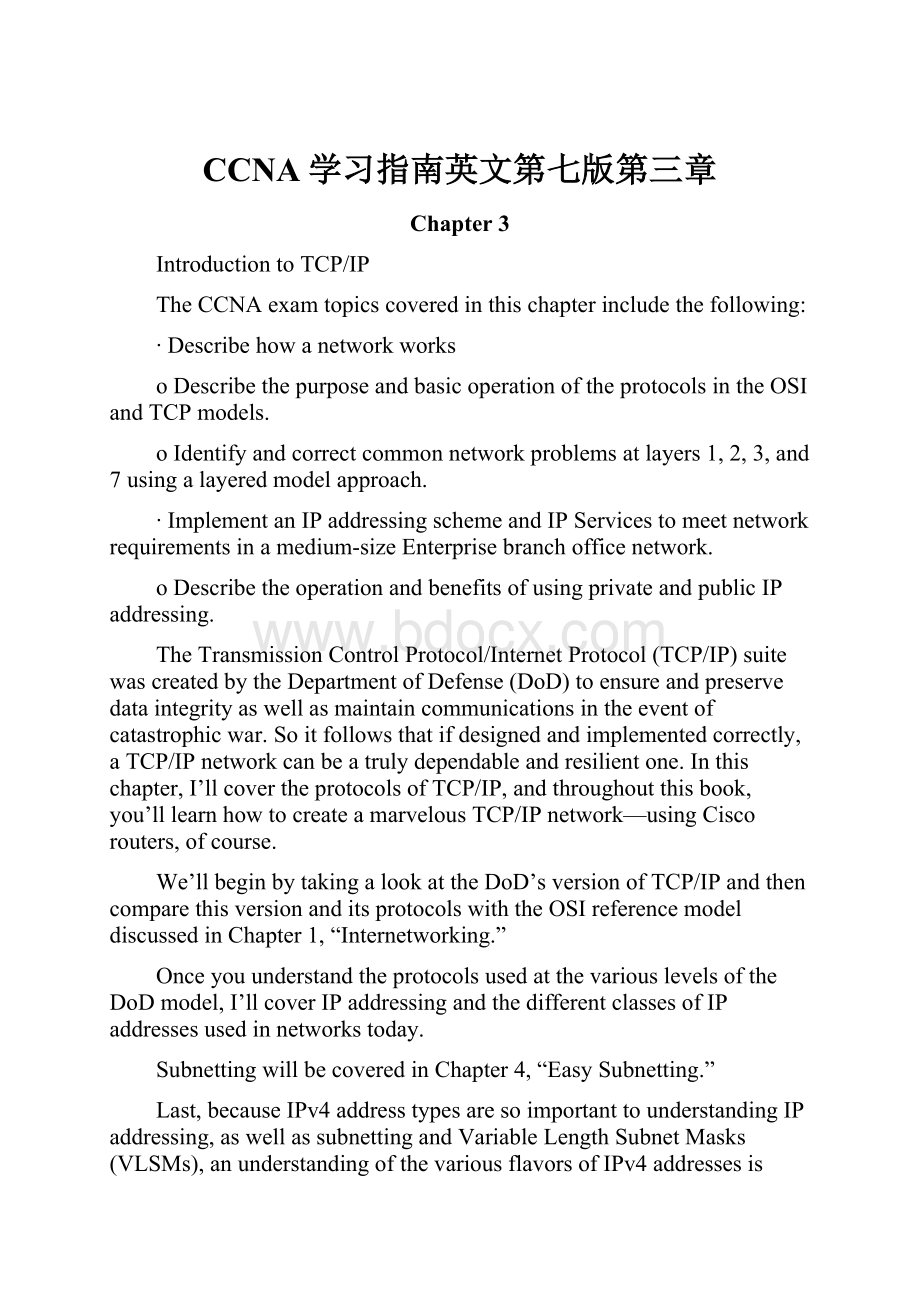 CCNA学习指南英文第七版第三章Word格式文档下载.docx
CCNA学习指南英文第七版第三章Word格式文档下载.docx
- 文档编号:22234528
- 上传时间:2023-02-03
- 格式:DOCX
- 页数:63
- 大小:766.84KB
CCNA学习指南英文第七版第三章Word格式文档下载.docx
《CCNA学习指南英文第七版第三章Word格式文档下载.docx》由会员分享,可在线阅读,更多相关《CCNA学习指南英文第七版第三章Word格式文档下载.docx(63页珍藏版)》请在冰豆网上搜索。

The
TransmissionControlProtocol/InternetProtocol(TCP/IP)
suitewascreatedbytheDepartmentofDefense(DoD)toensureandpreservedataintegrityaswellasmaintaincommunicationsintheeventofcatastrophicwar.Soitfollowsthatifdesignedandimplementedcorrectly,aTCP/IPnetworkcanbeatrulydependableandresilientone.Inthischapter,I’llcovertheprotocolsofTCP/IP,andthroughoutthisbook,you’lllearnhowtocreateamarvelousTCP/IPnetwork—usingCiscorouters,ofcourse.
We’llbeginbytakingalookattheDoD’sversionofTCP/IPandthencomparethisversionanditsprotocolswiththeOSIreferencemodeldiscussedinChapter1,“Internetworking.”
OnceyouunderstandtheprotocolsusedatthevariouslevelsoftheDoDmodel,I’llcoverIPaddressingandthedifferentclassesofIPaddressesusedinnetworkstoday.
SubnettingwillbecoveredinChapter4,“EasySubnetting.”
Last,becauseIPv4addresstypesaresoimportanttounderstandingIPaddressing,aswellassubnettingandVariableLengthSubnetMasks(VLSMs),anunderstandingofthevariousflavorsofIPv4addressesiscritical.I’llfinishthechapterwithvarioustypesofIPv4addressesthatyoujustmustknow.
InternetProtocolversion6willnotbediscussedinthischapter;
thischapterwillfocussolelyonIPv4.IPv6willbecoveredinChapter15,“InternetProtocolVersion6(IPv6).”Also,whenIdiscussInternetProtocolVersion4,you’llseeitwrittenasjustIP,nottypicallyIPv4.
IntroducingTCP/IP
BecauseTCP/IPissocentraltoworkingwiththeInternetandintranets,it’sessentialforyoutounderstanditindetail.I’llbeginbygivingyousomebackgroundonTCP/IPandhowitcameaboutandthenmoveontodescribingtheimportanttechnicalgoalsdefinedbytheoriginaldesigners.Afterthat,you’llfindouthowTCP/IPcomparestoatheoreticalmodel—theOpenSystemsInterconnection(OSI)model.
ABriefHistoryofTCP/IP
TCP/IPfirstcameonthescenein1973.Later,in1978,itwasdividedintotwodistinctprotocols:
TCPandIP.Then,in1983,TCP/IPreplacedtheNetworkControlProtocol(NCP)andwasauthorizedastheofficialmeansofdatatransportforanythingconnectingtoARPAnet,theInternet’sancestorthatwascreatedbyARPA,theDoD’sAdvancedResearchProjectsAgency,waybackin1957inreactiontotheSoviet’slaunchingofSputnik.ARPAwassoonredubbedDARPA,anditwasdividedintoARPAnetandMILNET(alsoin1983);
bothwerefinallydissolvedin1990.
Butcontrarytowhatyoumightthink,mostofthedevelopmentworkonTCP/IPhappenedatUCBerkeleyinNorthernCalifornia,whereagroupofscientistsweresimultaneouslyworkingontheBerkeleyversionofUNIX,whichsoonbecameknownastheBSD,orBerkeleySoftwareDistribution,seriesofUNIXversions.Ofcourse,becauseTCP/IPworkedsowell,itwaspackagedintosubsequentreleasesofBSDUNIXandofferedtootheruniversitiesandinstitutionsiftheyboughtthedistributiontape.Sobasically,BSDUnixbundledwithTCP/IPbeganassharewareintheworldofacademiaand,asaresult,becamethebasisofthehugesuccessandexponentialgrowthoftoday’sInternetaswellassmaller,privateandcorporateintranets.
Asusual,whatmayhavestartedasasmallgroupofTCP/IPaficionadosevolved,andasitdid,theU.S.governmentcreatedaprogramtotestanynewpublishedstandardsandmakesuretheypassedcertaincriteria.ThiswastoprotectTCP/IP’sintegrityandtoensurethatnodeveloperchangedanythingtoodramaticallyoraddedanyproprietaryfeatures.It’sthisveryquality—thisopen-systemsapproachtotheTCP/IPfamilyofprotocols—thatprettymuchsealeditspopularitybecauseitguaranteesasolidconnectionbetweenmyriadhardwareandsoftwareplatformswithnostringsattached.
TCP/IPandtheDoDModel
TheDoDmodelisbasicallyacondensedversionoftheOSImodel—it’scomposedoffour,insteadofseven,layers:
∙Process/Applicationlayer
∙Host-to-Hostlayer
∙Internetlayer
∙NetworkAccesslayer
Figure3-1
showsacomparisonoftheDoDmodelandtheOSIreferencemodel.Asyoucansee,thetwoaresimilarinconcept,buteachhasadifferentnumberoflayerswithdifferentnames.
WhenthedifferentprotocolsintheIPstackarediscussed,thelayersoftheOSIandDoDmodelsareinterchangeable.Inotherwords,theInternetlayerandtheNetworklayerdescribethesamething,asdotheHost-to-HostlayerandtheTransportlayer.
Figure3-1:
TheDoDandOSImodels
AvastarrayofprotocolscombineattheDoDmodel’s
Process/Applicationlayer
tointegratethevariousactivitiesanddutiesspanningthefocusoftheOSI’scorrespondingtopthreelayers(Application,Presentation,andSession).We’llbelookingcloselyatthoseprotocolsinthenextpartofthischapter.TheProcess/Applicationlayerdefinesprotocolsfornode-to-nodeapplicationcommunicationandalsocontrolsuser-interfacespecifications.
Host-to-Hostlayer
parallelsthefunctionsoftheOSI’sTransportlayer,definingprotocolsforsettinguptheleveloftransmissionserviceforapplications.Ittacklesissuessuchascreatingreliableend-to-endcommunicationandensuringtheerror-freedeliveryofdata.Ithandlespacketsequencingandmaintainsdataintegrity.
Internetlayer
correspondstotheOSI’sNetworklayer,designatingtheprotocolsrelatingtothelogicaltransmissionofpacketsovertheentirenetwork.IttakescareoftheaddressingofhostsbygivingthemanIP(InternetProtocol)address,andithandlestheroutingofpacketsamongmultiplenetworks.
AtthebottomoftheDoDmodel,the
NetworkAccesslayer
implementsthedataexchangebetweenthehostandthenetwork.TheequivalentoftheDataLinkandPhysicallayersoftheOSImodel,theNetworkAccesslayeroverseeshardwareaddressinganddefinesprotocolsforthephysicaltransmissionofdata.
TheDoDandOSImodelsarealikeindesignandconceptandhavesimilarfunctionsinsimilarlayers.
Figure3-2
showstheTCP/IPprotocolsuiteandhowitsprotocolsrelatetotheDoDmodellayers.
Inthefollowingsections,wewilllookatthedifferentprotocolsinmoredetail,startingwiththeProcess/Applicationlayerprotocols.
TheProcess/ApplicationLayerProtocols
Inthefollowingsections,I’lldescribethedifferentapplicationsandservicestypicallyusedinIPnetworks.Thefollowingprotocolsandapplicationsarecovered:
∙Telnet
∙FTP
∙TFTP
∙NFS
∙SMTP
∙POP
∙IMAP4
∙TLS
∙SIP(VoIP)
∙RTP(VoIP)
∙LPD
∙XWindow
∙SNMP
∙SSH
∙HTTP
∙HTTPS
∙NTP
∙NNTP
∙SCP
∙LDAP
∙IGMP
∙LPR
∙DNS
∙DHCP/BootP
Figure3-2:
TheTCP/IPprotocolsuite
Telnet
Telnet
isthechameleonofprotocols—itsspecialtyisterminalemulation.Itallowsauseronaremoteclientmachine,calledtheTelnetclient,toaccesstheresourcesofanothermachine,theTelnetserver.TelnetachievesthisbypullingafastoneontheTelnetserverandmakingtheclientmachineappearasthoughitwereaterminaldirectlyattachedtothelocalnetwork.Thisprojectionisactuallyasoftwareimage—avirtualterminalthatcaninteractwiththechosenremotehost.
Theseemulatedterminalsareofthetext-modetypeandcanexecutedefinedproceduressuchasdisplayingmenusthatgiveuserstheopportunitytochooseoptionsandaccesstheapplicationsonthedupedserver.UsersbeginaTelnetsessionbyrunningtheTelnetclientsoftwareandthenloggingintotheTelnetserver.
FileTransferProtocol(FTP)
FileTransferProtocol(FTP)
istheprotocolthatactuallyletsustransferfiles,anditcanaccomplishthisbetweenanytwomachinesusingit.ButFTPisn’tjustaprotocol;
it’salsoaprogram.Operatingasaprotocol,FTPisusedbyapplications.Asaprogram,it’semployedbyuserstoperformfiletasksbyhand.FTPalsoallowsforaccesstobothdirectoriesandfilesandcanaccomplishcertaintypesofdirectoryoperations,suchasrelocatingintodifferentones.
AccessingahostthroughFTPisonlythefirststep,though.Usersmustthenbesubjectedtoanauthenticationloginthat’sprobablysecuredwithpasswordsandusernamesimplementedbysystemadministratorstorestrictaccess.Youcangetaroundthissomewhatbyadoptingtheusername
anonymous—thoughwhatyou’llgainaccesstowillbelimited.
Evenwhenemployedbyusersmanuallyasaprogram,FTP’sfunctionsarelimitedtolistingandmanipulatingdirectories,typingfilecontents,andcopyingfilesbetweenhosts.Itcan’texecuteremotefilesasprograms.
TrivialFileTransferProtocol(TFTP)
TrivialFileTransferProtocol(TFTP)
isthestripped-down,stockversionofFTP,butit’stheprotocolofchoiceifyouknowexactlywhatyouwantandwheretofindit,plusit’ssoeasytouseandit’sfasttoo!
Itdoesn’tgiveyoutheabundanceoffunctionsthatFTPdoes,though.TFTPhasnodirectory-browsingabilities;
itcandonothingbutsendandreceivefiles.Thiscompactlittleprotocolalsoskimpsinthedatadepartment,sendingmuchsmallerblocksofdatathanFTP,andthere’snoauthenticationaswithFTP,soit’sevenmoreinsecure.Fewsitessupportitbecauseoftheinherentsecurityrisks.
NetworkFileSystem(NFS)
NetworkFileSystem(NFS)
isajewelofaprotocolspecializinginfilesharing.Itallowstwodi
- 配套讲稿:
如PPT文件的首页显示word图标,表示该PPT已包含配套word讲稿。双击word图标可打开word文档。
- 特殊限制:
部分文档作品中含有的国旗、国徽等图片,仅作为作品整体效果示例展示,禁止商用。设计者仅对作品中独创性部分享有著作权。
- 关 键 词:
- CCNA 学习指南 英文 第七 第三
 冰豆网所有资源均是用户自行上传分享,仅供网友学习交流,未经上传用户书面授权,请勿作他用。
冰豆网所有资源均是用户自行上传分享,仅供网友学习交流,未经上传用户书面授权,请勿作他用。


 广东省普通高中学业水平考试数学科考试大纲Word文档下载推荐.docx
广东省普通高中学业水平考试数学科考试大纲Word文档下载推荐.docx
